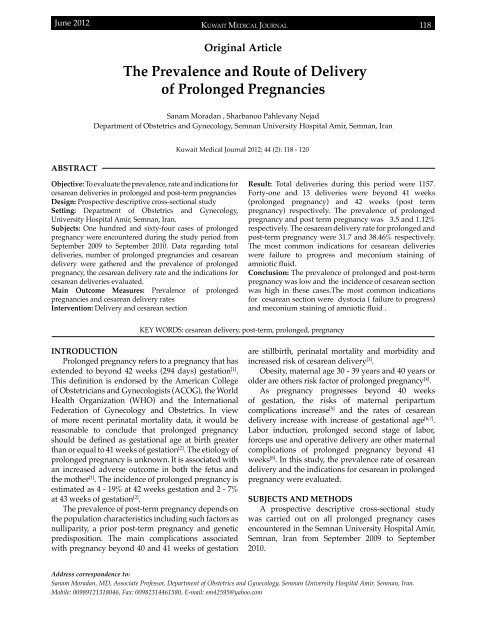Vol 44 # 2 June 2012 - Kma.org.kw
Vol 44 # 2 June 2012 - Kma.org.kw
Vol 44 # 2 June 2012 - Kma.org.kw
You also want an ePaper? Increase the reach of your titles
YUMPU automatically turns print PDFs into web optimized ePapers that Google loves.
<strong>June</strong> <strong>2012</strong><br />
KUWAIT MEDICAL JOURNAL 118<br />
Original Article<br />
The Prevalence and Route of Delivery<br />
of Prolonged Pregnancies<br />
Sanam Moradan , Sharbanoo Pahlevany Nejad<br />
Department of Obstetrics and Gynecology, Semnan University Hospital Amir, Semnan, Iran<br />
ABSTRACT<br />
Kuwait Medical Journal <strong>2012</strong>; <strong>44</strong> (2): 118 - 120<br />
Objective: To evaluate the prevalence, rate and indications for<br />
cesarean deliveries in prolonged and post-term pregnancies<br />
Design: Prospective descriptive cross-sectional study<br />
Setting: Department of Obstetrics and Gynecology,<br />
University Hospital Amir, Semnan, Iran.<br />
Subjects: One hundred and sixty-four cases of prolonged<br />
pregnancy were encountered during the study period from<br />
September 2009 to September 2010. Data regarding total<br />
deliveries, number of prolonged pregnancies and cesarean<br />
delivery were gathered and the prevalence of prolonged<br />
pregnancy, the cesarean delivery rate and the indications for<br />
cesarean deliveries evaluated.<br />
Main Outcome Measures: Prevalence of prolonged<br />
pregnancies and cesarean delivery rates<br />
Intervention: Delivery and cesarean section<br />
Result: Total deliveries during this period were 1157.<br />
Forty-one and 13 deliveries were beyond 41 weeks<br />
(prolonged pregnancy) and 42 weeks (post term<br />
pregnancy) respectively. The prevalence of prolonged<br />
pregnancy and post term pregnancy was 3.5 and 1.12%<br />
respectively. The cesarean delivery rate for prolonged and<br />
post-term pregnancy were 31.7 and 38.46% respectively.<br />
The most common indications for cesarean deliveries<br />
were failure to progress and meconium staining of<br />
amniotic fluid.<br />
Conclusion: The prevalence of prolonged and post-term<br />
pregnancy was low and the incidence of cesarean section<br />
was high in these cases.The most common indications<br />
for cesarean section were dystocia ( failure to progress)<br />
and meconium staining of amniotic fluid .<br />
KEY WORDS: cesarean delivery, post-term, prolonged, pregnancy<br />
INTRODUCTION<br />
Prolonged pregnancy refers to a pregnancy that has<br />
extended to beyond 42 weeks (294 days) gestation [1] .<br />
This definition is endorsed by the American College<br />
of Obstetricians and Gynecologists (ACOG), the World<br />
Health Organization (WHO) and the International<br />
Federation of Gynecology and Obstetrics. In view<br />
of more recent perinatal mortality data, it would be<br />
reasonable to conclude that prolonged pregnancy<br />
should be defined as gestational age at birth greater<br />
than or equal to 41 weeks of gestation [2] . The etiology of<br />
prolonged pregnancy is unknown. It is associated with<br />
an increased adverse outcome in both the fetus and<br />
the mother [1] . The incidence of prolonged pregnancy is<br />
estimated as 4 - 19% at 42 weeks gestation and 2 - 7%<br />
at 43 weeks of gestation [2] .<br />
The prevalence of post-term pregnancy depends on<br />
the population characteristics including such factors as<br />
nulliparity, a prior post-term pregnancy and genetic<br />
predisposition. The main complications associated<br />
with pregnancy beyond 40 and 41 weeks of gestation<br />
are stillbirth, perinatal mortality and morbidity and<br />
increased risk of cesarean delivery [3] .<br />
Obesity, maternal age 30 - 39 years and 40 years or<br />
older are others risk factor of prolonged pregnancy [4] .<br />
As pregnancy progresses beyond 40 weeks<br />
of gestation, the risks of maternal peripartum<br />
complications increase [5] and the rates of cesarean<br />
delivery increase with increase of gestational age [6,7] .<br />
Labor induction, prolonged second stage of labor,<br />
forceps use and operative delivery are other maternal<br />
complications of prolonged pregnancy beyond 41<br />
weeks [8] . In this study, the prevalence rate of cesarean<br />
delivery and the indications for cesarean in prolonged<br />
pregnancy were evaluated.<br />
SUBJECTS AND METHODS<br />
A prospective descriptive cross-sectional study<br />
was carried out on all prolonged pregnancy cases<br />
encountered in the Semnan University Hospital Amir,<br />
Semnan, Iran from September 2009 to September<br />
2010.<br />
Address correspondence to:<br />
Sanam Moradan, MD, Associate Professor, Department of Obstetrics and Gynecology, Semnan University Hospital Amir, Semnan, Iran.<br />
Mobile: 00989121318046, Fax: 0098231<strong>44</strong>61580, E-mail: sm42595@yahoo.com
















